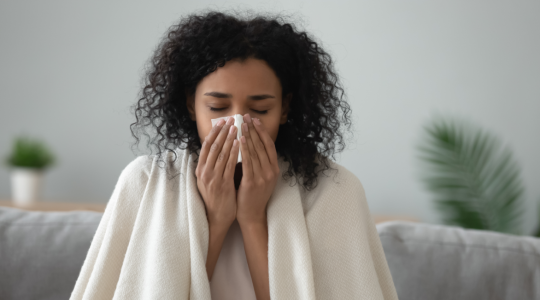Rising pollen levels pose challenges for individuals with sensitivities
By
Gian T
- Replies 5
As the flowers bloom and the grasses sway, the beauty of Australian landscapes is undeniable.
But this picturesque scene comes with a hidden threat for hay fever and asthma sufferers.
The state is currently experiencing a surge in pollen levels, which can trigger uncomfortable and dangerous respiratory symptoms.
After a particularly difficult Saturday evening, where many Victorians grappled with exacerbated symptoms, the Melbourne Pollen Count and Forecast has issued a warning: brace yourselves for another wave of high or extreme grass pollen levels.
The service's chief operating officer, Dr Edwin Lampugnani, reported a steady increase in grass pollen counts over the past day.
'That culminated last night at about eight o'clock, when levels reached very significant levels, extreme levels before they slowly dropped, but still remained within the extreme banding until about 7 am this morning,' he cautioned.
Unfortunately, the relief was fleeting. The forecast predicts high grass pollen levels across much of Victoria, with extreme levels expected in the north-central and northeast regions.
'We anticipate that this afternoon will be challenging for most people with hay fever, particularly those with asthma,' Dr Lampugnani added.
Adding to the concern, VicEmergency has highlighted a high risk of thunderstorm asthma in East Gippsland—a phenomenon in which high humidity and a certain type of thunderstorm can lead to a sudden increase in asthma attacks among the population.
Dr Lampugnani reminded us that we are now in the thick of Victoria's core grass pollen season, a period typically marked by numerous days of high and extreme pollen counts.
'So it's very important that if you have hay fever and asthma, you are prepared,' he advised.
'If you have asthma, make sure you have an asthma action plan in place. If you have severe hay fever, make sure you've gone to a GP or a pharmacist and sought that advice that you clearly need.'
Australians were alerted earlier this year that hay fever season began earlier than usual.
Doctors have reported a rise in hay fever cases linked to changes in weather and an earlier onset of pollen. For more details, click here.
Bupa Clinical Director Dr. Tony MacDermott advised asthma sufferers to be mindful of symptoms that may overlap with hay fever. You can read more about it here.

What might changing weather patterns mean for pollen levels and health in Victoria? How can the community better prepare for extreme pollen events? You can read more about it here.
But this picturesque scene comes with a hidden threat for hay fever and asthma sufferers.
The state is currently experiencing a surge in pollen levels, which can trigger uncomfortable and dangerous respiratory symptoms.
After a particularly difficult Saturday evening, where many Victorians grappled with exacerbated symptoms, the Melbourne Pollen Count and Forecast has issued a warning: brace yourselves for another wave of high or extreme grass pollen levels.
The service's chief operating officer, Dr Edwin Lampugnani, reported a steady increase in grass pollen counts over the past day.
'That culminated last night at about eight o'clock, when levels reached very significant levels, extreme levels before they slowly dropped, but still remained within the extreme banding until about 7 am this morning,' he cautioned.
Unfortunately, the relief was fleeting. The forecast predicts high grass pollen levels across much of Victoria, with extreme levels expected in the north-central and northeast regions.
'We anticipate that this afternoon will be challenging for most people with hay fever, particularly those with asthma,' Dr Lampugnani added.
Adding to the concern, VicEmergency has highlighted a high risk of thunderstorm asthma in East Gippsland—a phenomenon in which high humidity and a certain type of thunderstorm can lead to a sudden increase in asthma attacks among the population.
Dr Lampugnani reminded us that we are now in the thick of Victoria's core grass pollen season, a period typically marked by numerous days of high and extreme pollen counts.
'So it's very important that if you have hay fever and asthma, you are prepared,' he advised.
'If you have asthma, make sure you have an asthma action plan in place. If you have severe hay fever, make sure you've gone to a GP or a pharmacist and sought that advice that you clearly need.'
Australians were alerted earlier this year that hay fever season began earlier than usual.
Doctors have reported a rise in hay fever cases linked to changes in weather and an earlier onset of pollen. For more details, click here.
Bupa Clinical Director Dr. Tony MacDermott advised asthma sufferers to be mindful of symptoms that may overlap with hay fever. You can read more about it here.
Key Takeaways
- Hay fever and asthma sufferers in Victoria experienced a challenging weekend due to extreme grass pollen levels.
- The grass pollen count reached extreme levels on a Saturday night and is expected to remain high in most parts of Victoria.
- VicEmergency warned of a high risk of thunderstorm asthma in East Gippsland.
- Individuals with hay fever and asthma are urged to be prepared, have an action plan, and seek advice from GPs or pharmacists.
What might changing weather patterns mean for pollen levels and health in Victoria? How can the community better prepare for extreme pollen events? You can read more about it here.








